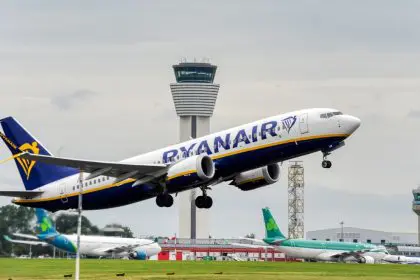You packed your bags, arrived three hours early, and even splurged on those noise-canceling headphones for the flight. But if you’re going through Newark Liberty International Airport right now, you might as well have packed a sleeping bag and a week’s worth of snacks too.
Newark Airport has descended into what can only be described as aviation purgatory, with hundreds of stranded travelers, mounting cancellations, and delays that have stretched from hours into days. The chaos shows no signs of letting up, leaving summer travelers wondering if they’ll ever reach their destinations.
A multi-headed monster of airport dysfunction
The situation at Newark isn’t just bad luck or typical summer travel woes. It’s a perfect storm of issues converging at once, creating a nightmare scenario that has airlines canceling dozens of flights.
The chaos stems from a messy cocktail of problems. Runway construction has squeezed available flight paths. Equipment issues at air traffic control facilities that manage Newark’s airspace have created additional complications. Staffing shortages among air traffic personnel have reached concerning levels. And if that wasn’t enough, weather complications keep adding fuel to the fire.
By Monday morning, nearly 100 flights had been canceled and more than 50 delayed. This follows a weekend where many travelers found themselves sleeping on terminal floors, missing connecting flights, and watching their vacations disintegrate hour by hour.
United Airlines takes drastic measures
When a major airline takes drastic measures, you know things have gone off the rails. The primary carrier at Newark, which uses this airport as its East Coast hub, has taken the extraordinary step of slashing 35 roundtrip flights daily from its Newark schedule.
The airline’s leadership has expressed significant concerns about operational challenges at the airport, pointing to various factors that have created unsustainable conditions. These include longstanding issues with air traffic management that reportedly intensified in recent days.
What’s clear is that the carrier felt it had no choice but to dramatically reduce operations. The airline has reportedly been advocating for better regulation of flight volume at Newark for years, arguing that scheduled flights often exceed what the infrastructure can realistically handle. Now travelers are paying the price for what appears to be a culmination of various systemic issues.
Stranded passengers left searching for options
The human toll of this administrative disaster is playing out in real time across Newark’s terminals. Travelers report being stranded for multiple days, unable to rebook flights as cancellations ripple through the system.
Families with young children have been particularly hard-hit, forced to camp out in terminals with limited access to necessities. Business travelers have missed crucial meetings. And those traveling for special occasions like weddings and family reunions have watched helplessly as their carefully planned trips unraveled.
The financial impact extends beyond just ticket costs. Stranded passengers face unexpected hotel stays, meal expenses, and in some cases, rental cars for alternative transportation. Many travelers report difficulty getting compensation from airlines, who point to FAA issues as being beyond their control.
Air traffic controller staffing reaches breaking point
Behind the scenes, the air traffic control situation has reportedly reached concerning proportions. Air traffic personnel guide planes through some of the busiest and most complex airspace in the world, but staffing levels at facilities serving Newark have apparently reached problematic lows.
The regional air traffic control facility that helps manage Newark’s traffic has been particularly affected by staffing shortages. Personnel there are reportedly working extended shifts, raising potential fatigue concerns in a profession where mental sharpness is critical for safety.
The staffing challenges didn’t appear overnight. There have been ongoing difficulties with recruitment and training backlogs for years in the air traffic control system. The pandemic reportedly exacerbated these issues as training programs were disrupted and early retirements increased. Now the system appears to be operating with minimal redundancy, meaning even small disruptions can cause massive ripple effects.
Equipment failures compound human shortages
Aging FAA equipment has added another layer to the disaster. Technical issues at the Philadelphia TRACON center have repeatedly disrupted operations over the past week, forcing controllers to implement more conservative spacing between aircraft.
These equipment problems couldn’t come at a worse time, coinciding with runway construction at Newark that has already reduced the airport’s capacity. With fewer runways available and technical limitations on how efficiently the remaining runways can be used, delays become inevitable.
The FAA has acknowledged the equipment issues but hasn’t provided a timeline for permanent solutions. Meanwhile, each technical glitch sends new waves of delays through the system, affecting flights across the eastern seaboard.
Political pressure mounts for solutions
As the situation deteriorates, political leaders are stepping in. A prominent senator from New York is expected to call for an investigation into the problems plaguing Newark operations. The high-profile attention signals just how severe the disruptions have become.
The political dimension adds another layer of complexity. Questions about federal funding for air traffic control systems, staffing policies, and airport capacity limits are now center stage. But travelers stuck in terminals care less about who’s to blame and more about when they’ll finally get to their destinations.
What travelers can do to protect themselves
If you’re scheduled to fly through Newark in the coming days or weeks, you’re probably wondering if there’s anything you can do to avoid becoming another airport floor camper. While there are no guarantees in the current chaos, there are steps you can take to improve your odds.
Check flight status obsessively
Don’t wait for airline notifications, which often come too late for you to make alternative arrangements. Use flight tracking apps like FlightAware or Flightradar24 to monitor not just your flight but also the incoming aircraft that will become your flight. If that plane is delayed or canceled, you’ll be affected too.
Know your rights
Familiarize yourself with your airline’s cancellation and delay policies. In cases of mechanical issues or airline staffing problems, you’re entitled to certain accommodations or refunds. For weather and air traffic control delays, airline obligations are more limited, but knowing the policies gives you leverage when speaking with representatives.
Consider alternative airports
The New York area is served by three major airports. If you’re booking new travel, consider LaGuardia or JFK instead of Newark. For existing reservations, ask about the possibility of being rerouted through a different hub entirely, even if it means a less direct route.
Pack essentials in your carry-on
With the increased risk of separation from checked luggage during disruptions, pack medications, essential toiletries, a change of clothes, and any crucial items in your carry-on. Include chargers for your devices, as you may need them for rebooking or communication during extended delays.
Have a backup plan
Before leaving home, research alternative transportation options if you absolutely must reach your destination by a certain time. Know which trains, buses, or car rental services are available from Newark if flying becomes impossible.
The outlook remains stormy
Unfortunately for travelers, there’s no quick fix on the horizon. The controller staffing shortage requires long-term solutions including increased training capacity and competitive compensation to attract new talent. Equipment upgrades take time and significant investment. And the runway construction at Newark has its own timeline that can’t be easily accelerated.
United’s flight reductions may actually provide some relief by bringing scheduled operations more in line with what the system can currently handle. But for travelers who booked summer vacations months ago, this adjustment comes too late.
As the peak summer travel season continues, the situation at Newark serves as a sobering reminder of just how fragile our air transportation system has become. Years of underinvestment, staffing challenges, and increasing demand have created a system with almost no margin for error.
For now, travelers passing through Newark would be wise to pack their patience along with that extra power bank. The journey through this airport has become an adventure in itself, though not the kind anyone would choose for their summer vacation.

















